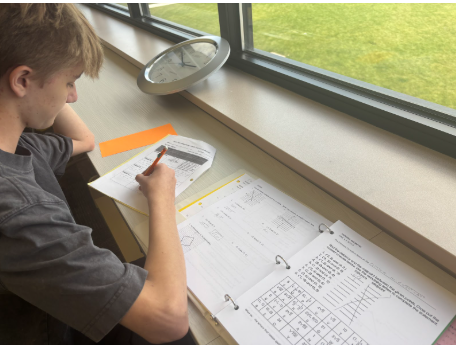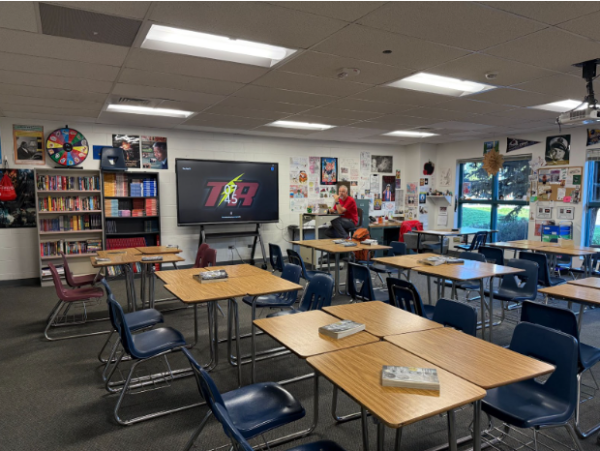To Kill a Love for Reading
The Necessity of Diverse Literature in our English Classes
Romeo and Juliet, Macbeth, The Great Gatsby, Lord of the Flies, Of Mice and Men, The Crucible, Tale of Two Cities, The Adventures of Huckleberry Finn
What do all these books have in common? They are “classics” — often from the 1800s or some other bygone era — written by white men, mostly in the genre of realistic or historical fiction. And, unfortunately, they make up the majority of our high school English reading curriculum.
The English curriculum is chosen solely by the teachers, coordinators, and the educational board, which is why it is no surprise that it reflects College Boards SAT/ACT and AP Literature reading list.
“I came into the curriculum twenty years ago with the curriculum already decided,” said English Department Coordinator, Jenette VanWormer.
Of Mice and White Men
The AP reading selections are normally made up of white male authors, depriving all students of other, equally important world views possessed by women or authors of different ethnicities or sexualities.
Grandview’s curriculum is no different. Out of all the required books read for English classes, from CP to AP, female authors make up less than 13% of the required books and minority groups make up only around 10%.
With the overwhelming majority of Western European and American male authors, minority groups often feel overlooked and excluded.
When given a survey on which book was the most relatable that Grandview students have read in English, the most popular answer was Catcher in the Rye, a coming to age novel about a white prep schoolboy in the 1940s, the second most overwhelming answer was none.
“I haven’t really related to most books,” said a Grandview junior in the survey.
The English curriculum has stayed mostly static since the 60s, and while there is a need to analyze older books, as it improves linguistic skills, reading similar “classics” constantly will not encourage any new discussion or ideas. The curriculum has simply not adapted to the 21st century.
“The ninth grade curriculum is similar to the classics I read in ninth grade,” said VanWormer.
The books we read for English are supposed to teach us history and universal themes like love, sacrifice, ambition, but when we are constantly reading the same type of book these themes become redundant and one-sided.
While many of these classic books are masterpieces, there are so many other books that tell important and overlooked stories from other cultures. Those including; Persepolis, which is by an Iranian author Marjane Satrapi, whose work details life surrounding the 1979 Iranian Revolution, Beloved by Toni Morrison, which centers around, Seethe, an escaped slave, The House on Mango Street by Sandras Cisneros, about a Latina girl who lives on Chicago’s Mango Street, Plague of Doves by Louise Erdrich that tells a Grandfather’s tribal stories and Ojibwe heritage to his mixed raced granddaughter and countless of other books. To leave those stories out of the English Curriculum effectively sends the message that the literary traditions of non-Western people are not important or relevant to us today.
With the increase in technology, new and diverse literature is at our fingertips, from music, to online literary journals, to even film. All of these mediums can be analyzed for literary devices and can be mixed into the curriculum for more relevant and stimulating discussions and connections.
Holly Hoggarth, both a librarian and English teacher at Grandview believes a diverse selection of books is essential for students.
“The best thing we could do for our students would be to have a mix: some books that are classics, some books that are contemporary and have a variety of authors and a variety of voices,” said Hoggarth. “I think that that balance would be really key.”
Death of a Reader
“We have a reading crisis right now,” said Van Wormer. “It’s not just kids, adults don’t read.”
Most English teachers seem to believe the fact that kids don’t read for pleasure anymore is a mystery.
The mystery is simple. Throughout elementary school, there were regular trips to the library, giving us free choice and time to read. All throughout elementary school, there was time built in for teachers to read to us. As we got older, free choice and class readings became less frequent. According to a survey conducted throughout Grandview, 29.9% of students admit to never read for pleasure, but only 14.9% admit that they never enjoy reading.
“It seems there is a big disconnect,” said Hoggarth. “Somewhere maybe around eighth, ninth or seventh-grade, kids seem to stop reading for joy.”
Students stop reading when the curriculum becomes formulaic, repetitive and not relatable.
After reading several similar books, a student may develop a general dislike for reading; however, exposure to a wider range of stories could likely persuade a reluctant reader to enjoy reading again.
“English is the only subject that has no freedom, and we learn nothing interesting except how to write an essay the way the teacher likes it,” said sophomore, Danijela Prizmic.
The English curriculum does not take advantage of what is supposed to be an art form. Art can be defined as communication between an artist and the audience. When an author writes, they take words to create a story to communicate to us. This communication is essential for learning about the world around us anecdotally and emotionally.
To illustrate, Freshman Seminar and health classes integrate issues like drug abuse, sexuality, bullying, sexual assault, mental health, etc. which has never been taken seriously by students. It’s “cringy” and prohibits students to truly discuss these issues. While schools understand the importance of integrating these issues, they are failing to see that they don’t belong wedged in a freshman’s almost-off period, but in a constant discussion that can be directed by the literature, we read in English, as a platform for these emotional connections.
According to both Van Wormer and Hoggarth, the purpose of English is to make students better readers, writers and most importantly, thinkers.
“Reading essays, reading articles and books, agreeing and disagreeing with them, hones in those thinking skills,” said Hoggarth. “Being able to think is one of the most important things a person could have.”
However, if students aren’t reading, they aren’t thinking. When students are bored, many turn to SparkNotes or Shmoop instead of reading or thinking freely for an essay. Students won’t read if the book is boring and especially if the teacher doesn’t make class engaging.
By including new and diverse works, discussions, and creative projects, the curriculum could break from its formula and encourage students to think outside of just what the teacher wants them to think.
“The number one mistake we could make is to stop reading,” said Van Wormer.
Featured Image courtesy of Google








![A Vest Won’t Protect You [OPINION]](https://ghschronicle.com/wp-content/uploads/2025/09/KoltonZuckerVestPosterOffWhite-450x600.png)
![Executive Order: Ending Radical Indoctrination in K-12 Schooling [OPINION]](https://ghschronicle.com/wp-content/uploads/2025/04/Screenshot-2025-04-23-at-2.51.41 PM-600x337.png)




A • Nov 17, 2018 at 9:35 am
I would just like to point out that you had a volunteer bias in the survey you used for this article. When you sent out the survey on google forms, my teacher and many others just said “take it if you want”. This skews your results toward the opposite of the point you’re trying to make, as people who enjoy English class more will tend to go onto their English class schoology page more often and be more likely to take your survey. This is not a random sample of the Grandview population nor does it represent the different identities of Grandview students in ratios similar to the ones we have in the school. I ask that in the future you conduct statistically correct surveys as they will not only give more accurate information but also make the articles more credible to people like me. (:
Brian Kurz • Nov 8, 2018 at 2:23 pm
This is a terrible article please stop writing these
Lain Iwakura • Nov 9, 2018 at 12:03 am
11/10 criticism. Not only was the argument posited on the article utterly obliterated, you have also solved the issue of diversity in literature in the foreseeable future, reinvigorated the world’s passion for reading, cured my depression, brought peace multiversal transdimensional peace for all time, and saved seven homeless puppies from Dr. Evil. Truly an analytical hero.
Lain Iwakura • Nov 7, 2018 at 3:08 pm
You’re misidentifying the problem on the issue of empathy. You’re right in that half of the two-fold purpose of art being to communicate experiences you wouldn’t have otherwise been able to experience on any level (the other half being as a hypothetical assertion and argument for values), but the issue isn’t a lack of exposure to minority-related issues (To Kill a Mockingbird, Night, Hiroshima, A Raisin in the Sun, and Of Mice and Men are all about minority issues, and they’re in Freshman year alone; if anything, it’s over-saturated), it’s that these experiences by-in-large aren’t current. We’re no longer living in the Jim Crow era, we’re living in the Stop-and-Frisk era. The experiences of the oppressed are fundamentally different now, and so in order to empathize, new books need to be adopted. The only reason Catcher in the Rye is so universally relatable to upper middle class cis straight white kids even today is that the fundamental experience of existing as that identity is the only one that hasn’t profoundly changed over time; Other literature designed for the sake of crafting empathy needs to be current in order to be effective. The problem is finding art with both significant literary value in this day and age that also communicates the experience effectively, which is an entirely separate issue.
The thing that ticks me off about this article, though, is more the slight-of-hand it pulls to make it seem like the lack of diversity is part of what’s killing the interest in reading. You don’t make an argument as to why what we read in English isn’t deemed enjoyable, and hence you imply that diversity in experience equates to enjoyment. On what basis? The reason the majority loves Catcher so much is that it represents their experience so well. Are you implying that diverse experiences are inherently better written? I think what you were trying to say was that modern experiences of minorities are likely to be better-written for today’s readership purely on the basis that they are modern, which is more reasonable, but still disagreeable, as ease of access doesn’t denote quality, only ease. Most literature worth reading on the level of its ideas is technical in style, and some of the most universally-emotional stories ever told, appealing to humanity rather than a specific experience with life, such as the tales of Shakespeare, are locked behind difficult language. Accessibility is only good when you are attempting to reach the masses who are unwilling to think and incapable of intellectual digestion, and I don’t think that’s the culture that school wants to encourage.
The actual issue is attention span and inability to understand texts enough to get invested in them, but that’s a much more complicated topic than I’m willing to write about here because I’m lazy and stupid.
Also, your definition of art is slightly inaccurate. It is not simply anything that communicates between an artist and audience, that’s what is referred to as a sign in semiology. Art, as I would define it, is a recreation based on some aspect of reality to convey values and potentially evoke emotions. Under your definition, every action anyone ever takes would be “art. “It doesn’t impact your article at all, but it’s an irritating technicality.
As for the claim that English teaches you nothing but how to write essays that your teacher enjoys, this is just fundamentally wrong. I do think how English class presents the issue makes it seem controlling, but the writing formula your teacher imposes on you in English is one that can be found in all quality literary analysis, unless the rules are being deliberately broken for very specific reasons (The greatest analytical essay of all time, The Philosophy of Kreia: A Critical Examination of Star Wars, literally doesn’t have a thesis statement, for instance, but that’s only because the other is a genius). And besides, the article itself argues that art communicates valuable experiences when they are digested correctly, so if the book selection is good and the teacher teaches the kids to actually get invested in what they’re reading, the class is valuable.
Lain Iwakura • Feb 26, 2019 at 9:48 am
Correction on this, you *do* make an argument as to why people don find books enjoyable, but it basically boils down to the fact that the classics are supposedly repetitive stylistically and tonally and that the themes of the books are repetitive, both of which, I would argue, are blatantly false. The prose styles are not what we see all the time today, of course, but if you mean to tell me that Catcher in the Rye, To Kill a Mockingbird, Macbeth, Lord of the Flies, and All Quiet on the Western Front have even remotely similar styles or themes then you would have to make an exceedingly compelling case to convince me of such. It’s not an issue of monotony, as you suggest, it’s an issue of the writings all being different from the style that’s easiest to understand. And as long as the ideas on these books are as universal as theyŕe intended to be, relatability shouldn’t be an issue. Diversity is a good thing in terms of helping to reduce cultural ignorance but it has relatively little to do with the overall interest in the medium, at least compared to how you presented the issue here.
Mackenzie • Nov 6, 2018 at 1:40 pm
This is a great point but how will students be able to understand literary references that are mentioned through life if they are not able to read the classics, it’s not like kids will want to read them unless it is in the curriculum.
Lain Iwakura • Nov 7, 2018 at 3:12 pm
Classical references die if the classics die. Also, the article isn’t advocating for getting rid of the classics, it advocates balance.
ur mum • Nov 3, 2018 at 4:25 pm
SO true the english deparmnet needs change